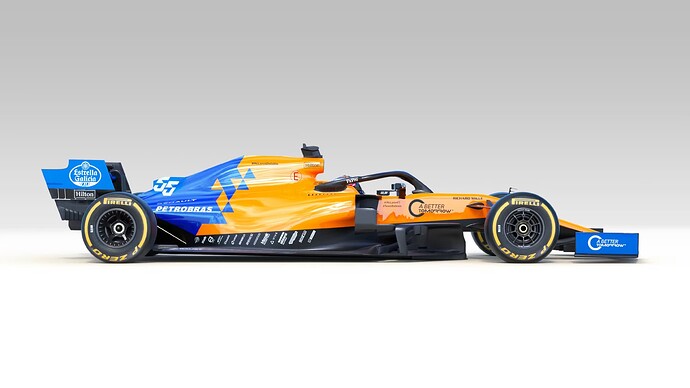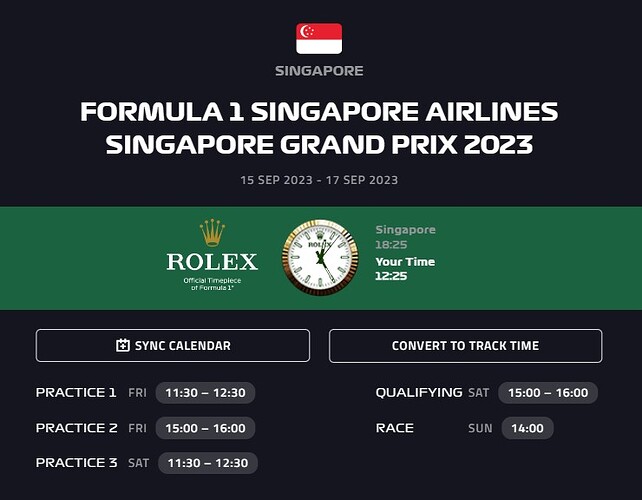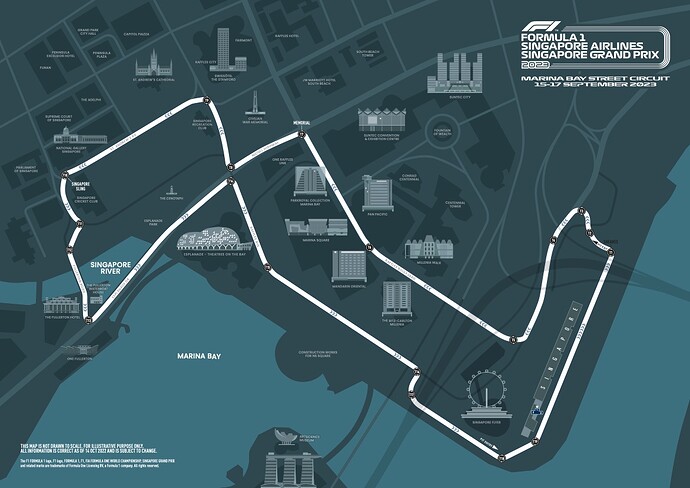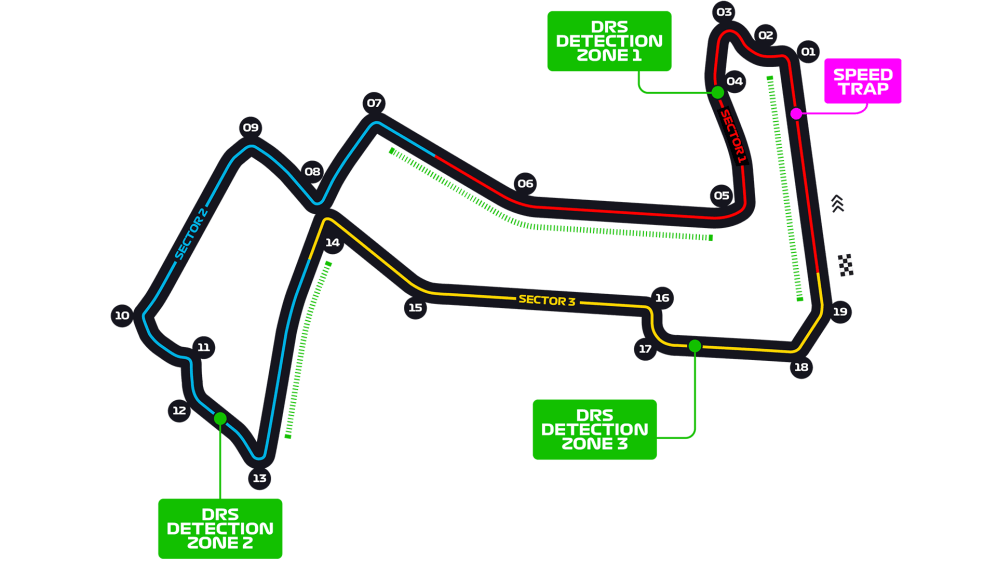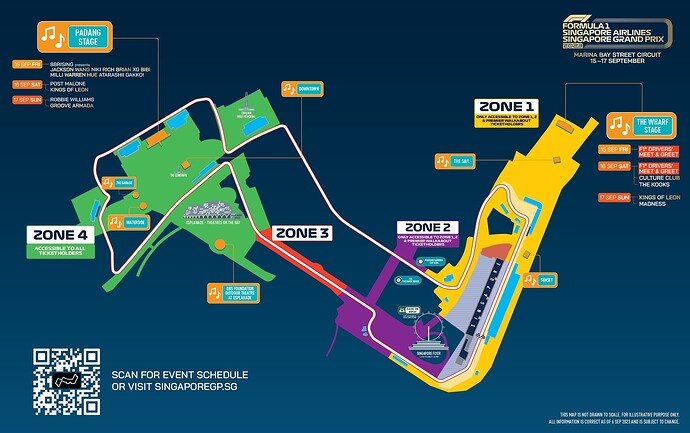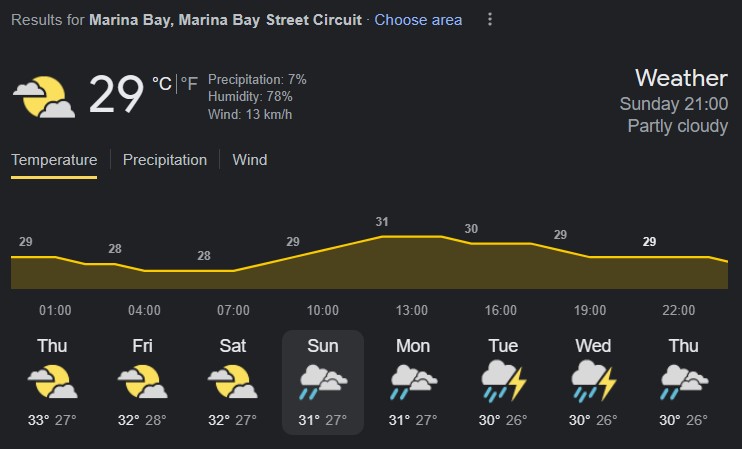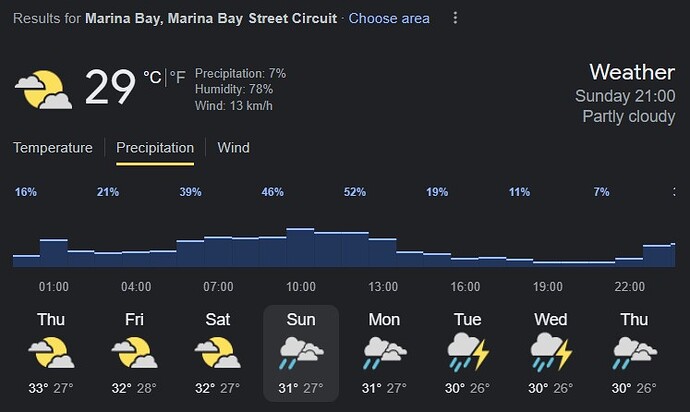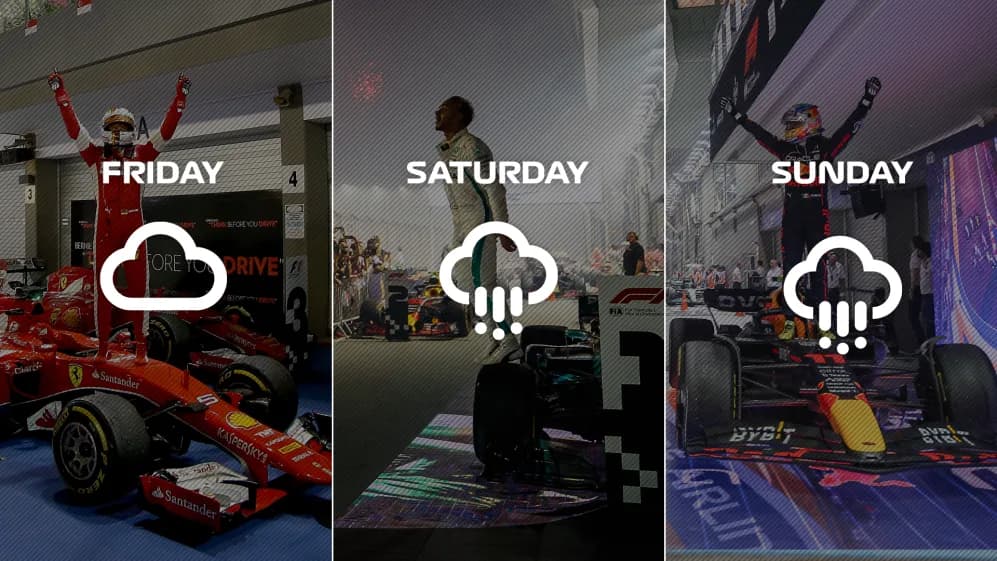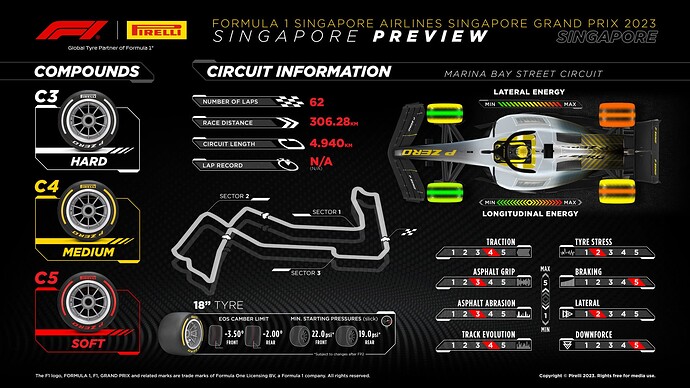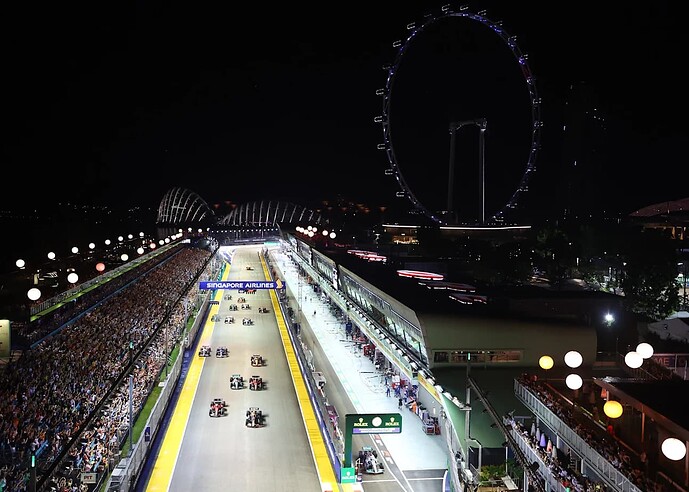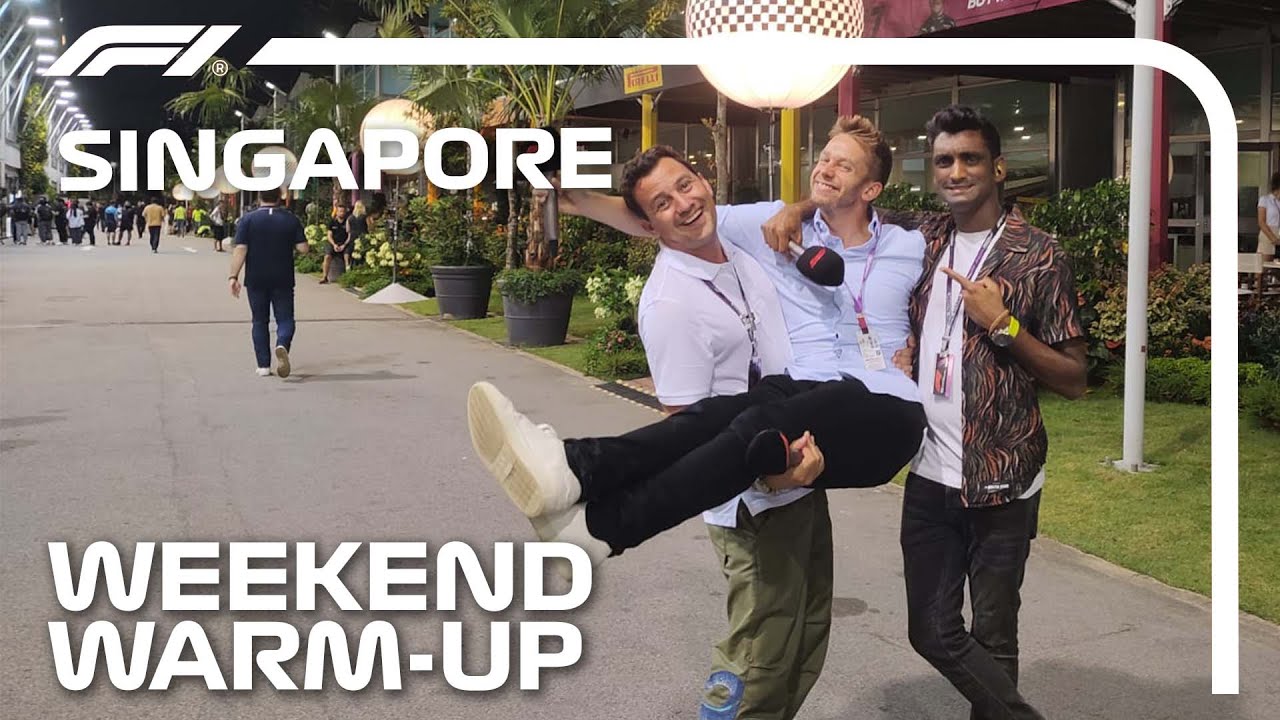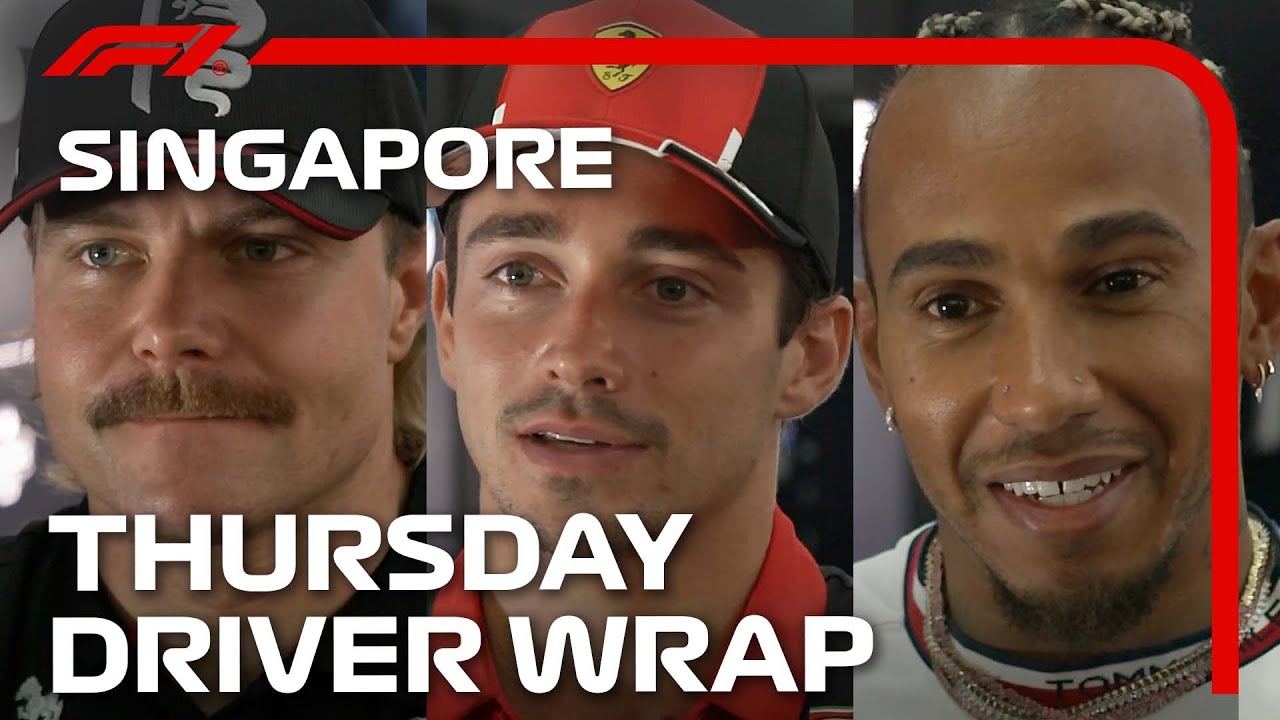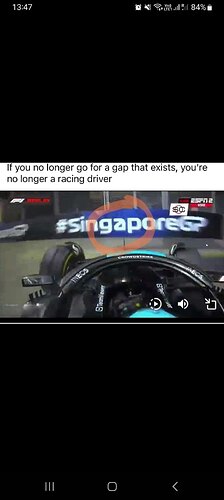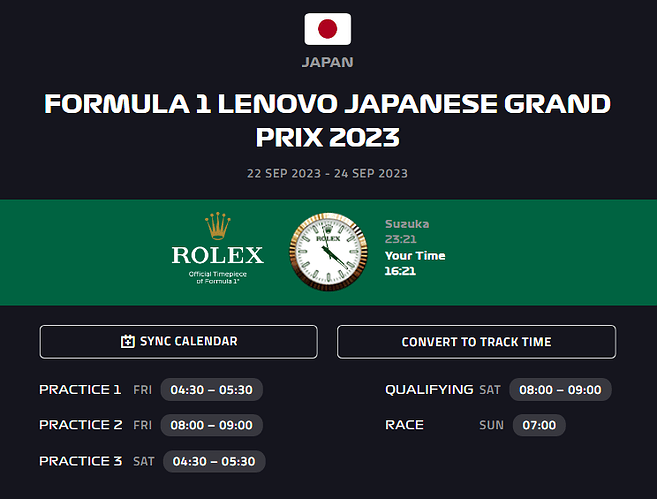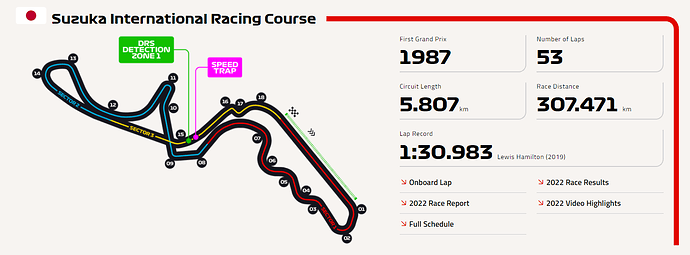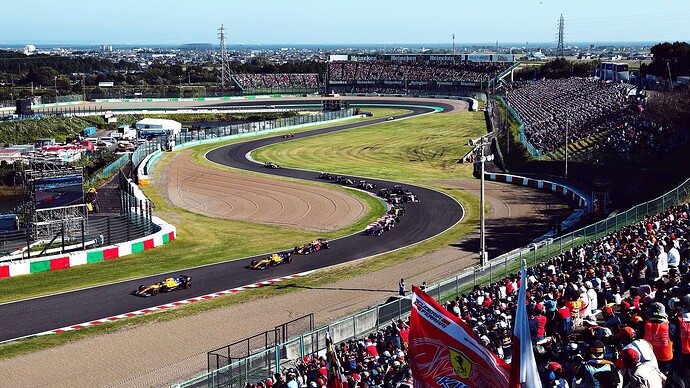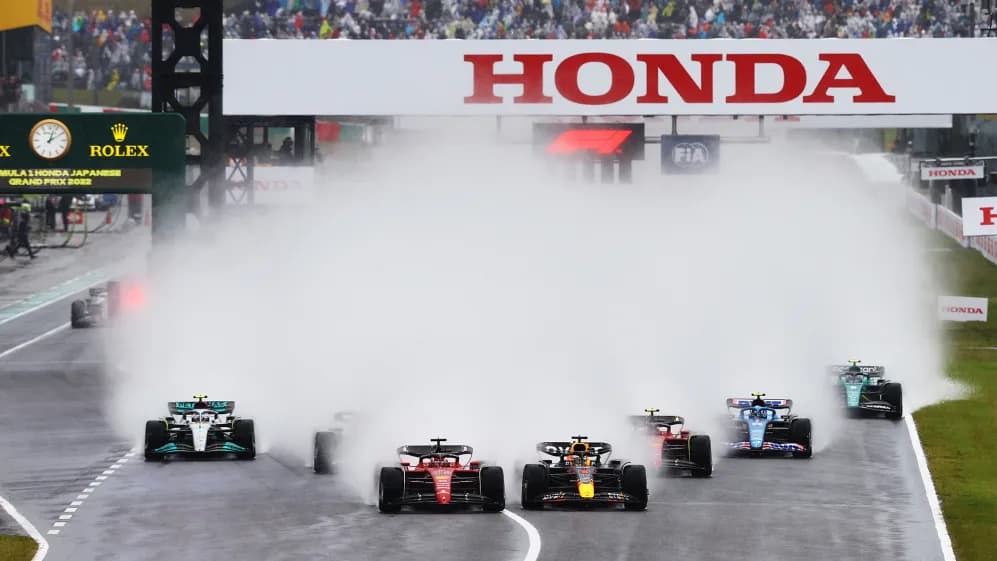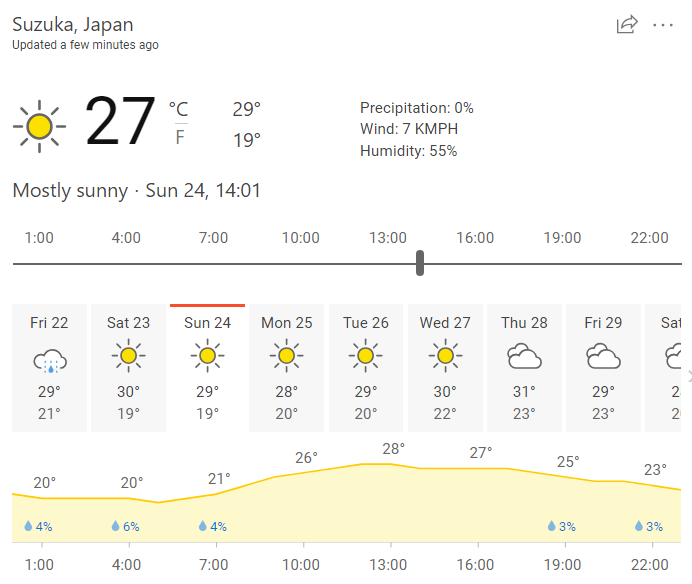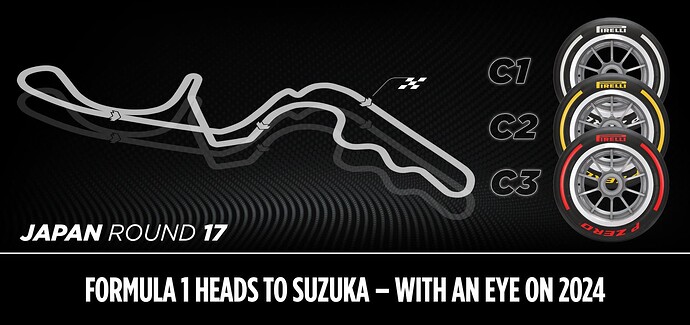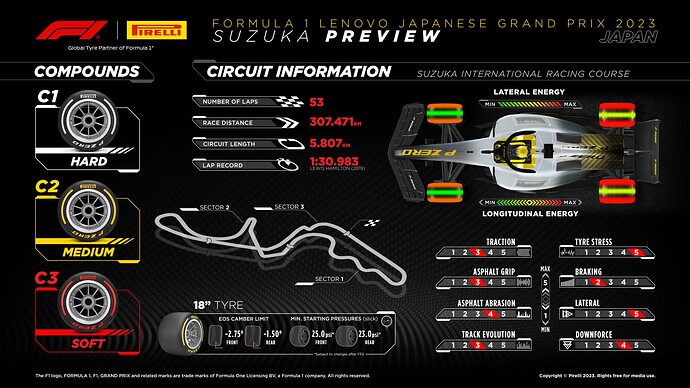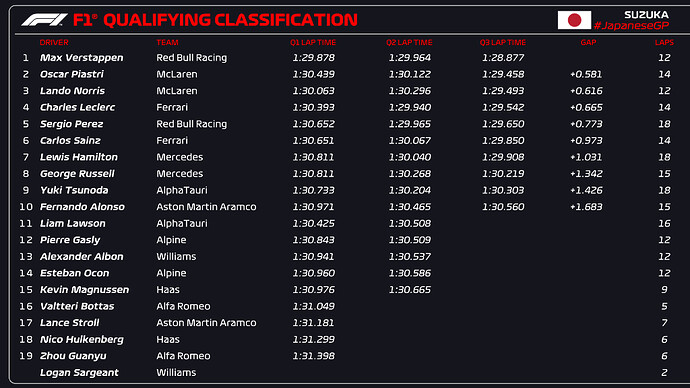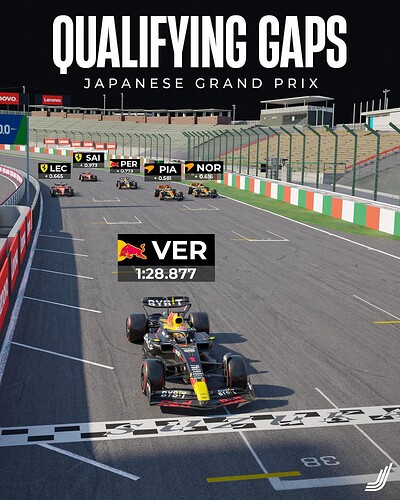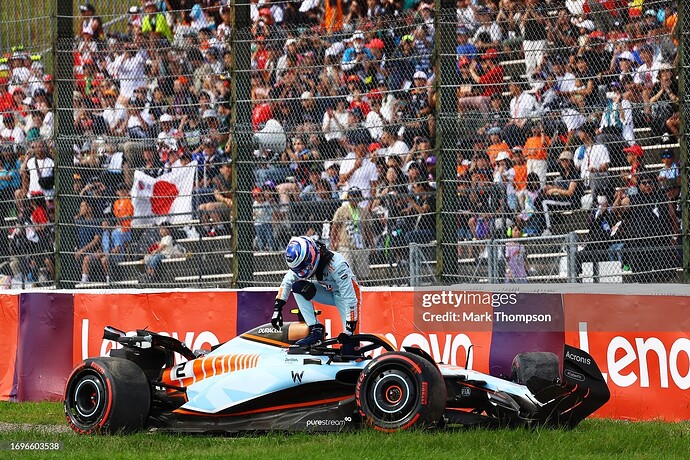Google doing an epic facepalm right now.
2023 Singapore Grand Prix 
Marina Bay Street Circuit | Marina Bay | Singapore | 17 September
2023 F1 Season - Round 16 (15/22)
Off to Asia we go on the first leg of the international fly away races for this year. First up are the Singapore and Japan races on back-to-back weekends. The Marina Bay Street Circuit will again play host to its 14th Grand Prix (albeit with a big change to the layout this year - see The Circuit notes below) - the original Night Race. The other Red Bull driver (some random Mexican chap I think) won here last year. Whether he can repeat that performance or whether the main Red Bull driver - championship leader Max Verstappen can clinch his 11th straight victory we’ll find out on Sunday. Either way, Red Bull remain odds on favourites to continue their new target of winning every race in the season.
The race and the circuit test the limits for both drivers and cars. It has some 90-degree turns, but with a high degree of variability, featuring technical sections and quick direction changes. Overtaking is primarily done at the end of the first sector, where top speeds are at their highest. Runoff areas exist at the end of the long straights but are short by Formula One standards. At most parts of the track, cars run very close to the walls. In general, victory is dependent on a drivers’ experience and skills.
The Singapore Grand Prix has been frequently described by drivers as being the “toughest race of the Formula 1 calendar”. The endurance of drivers is heavily strained due to various factors such as high heat, high humidity, high amount of sweat and bodily fluid loss, high number of corners (19 this year), little margin for error (due to the lack of run-off area within a street circuit) and race finishes always completing near to the 2-hour allocated time limit (with 4 races being time-limited, instead of completing the allotted laps).
Vital Statistics
- First Grand Prix – 2008
- Track Length – 4.940km
- Race Distance – 306.143km
- Lap record – N/A (Revised circuit layout)
- Most wins – Sebastian Vettel (5)
Last Five Winners
- 2022 – Sergio Perez (Red Bull)
- 2019 – Sebastian Vettel (Ferrari)
- 2018 – Lewis Hamilton (Mercedes)
- 2017 – Lewis Hamilton (Mercedes)
- 2016 – Nico Rosberg (Mercedes)
Trivia
- The first race held at the new Marina Bay Street Circuit in 2008 was also first fully night-time event in Formula 1 history.
- That first night race honour has since been tarnished by the Crashgate controversy. The race was won by Fernando Alonso driving for the Renault team. Renault were subsequently found to have ordered Nelson Piquet Jr. to purposely crash as the ensuing safety car would strongly benefit Alonso.
- The Marina Bay Circuit holds a unique record of having at least one safety car appearance in every F1 race heldd there to date. There have been a total of 23 safety car deployments in the previous 13 races.
The Schedule
Despite being 6 hours ahead of us, Singapore’s night racing makes broadcast times here super fine and mega dandy. Friday practice sessions are go at 11:30 and 15:00, while the final practice hour runs from 11:30 on Saturday. The stuff that matters - Qualifying and the Race - happen respectively on Saturday at 15:00, and on Sunday at 14:00
The Circuit
The Marina Bay Street Circuit (otherwise known as the Singapore Street Circuit) is a temporary street circuit around Marina Bay, Singapore, encompassing the areas of Downtown Core, Kallang, and Marina Bay. It has been the venue for all the Singapore Grands Prix since 2008.
circuit will have some major changes in the layout this year. The entire Stadium section between Turns 16 and 19 have been temporarily removed to facilitate the construction of NS Square, a new outdoor multipurpose venue that will replace the existing The Float@Marina Bay area. Construction is only expected to be completed toward the end of 2026, so expected the revided layout to be used for at least 4 years.
The revised layout now has a flat-out section that runs down Raffles Avenue until the new Turn 16 (formerly Turn 20). Because of the shortened circuit length and lap times expected to decrease by around 10 seconds, the number of race laps has been increased from 61 to 63. The removal of four slow corners will also increase the average lap speed and the race time is expected to now be completed within an hour and a half unlike previous editions usually lasting most of the two hour race time limit.
When was the track built?
The Marina Bay Circuit arrived on the scene in 2008. A street track with the city’s famous skyline as its spectacular backdrop, the initial circuit plan by Herman Tilke was refined by KBR Inc, while the event has quickly established itself as one of the standouts on the F1 calendar.
When was its first Grand Prix?
In 2008, Singapore had the honour of hosting the first night-time race in F1 history. The Grand Prix – the 15th round of that season – proved a huge hit with the teams and drivers, while Renault’s Fernando Alonso claimed a controversial victory.
What’s the circuit like?
The Marina Bay Circuit is one of the most physically demanding on the calendar, its bumpy street surface coupled with humid conditions giving the drivers plenty to think about. Even with a revised 2023 layout reducing the number of corners from 23 to 19, they are working the wheel a lot, too, around the high-speed lap – the physical stress causing them to lose as much as 3kg in body weight over the course of a race.
The Weather
One of the reasons that the Singapore GP is F1’s original night race is because Singapore is generally cooler and drier in the evening. Qualifying is at 21:00 and the Race at 20:00 local time. That said, it’s still ridiculously hot and humid, and there’s an ever present risk of that combination of factors turning into a proper downpour at any time. The weekend forecast looks the same as usual - high humidity, high temperatures, and a high chance of thunderstorms and rain during the day on Sunday, lessing into the evening.
Friday - FP1 and FP2
A chance of a shower or two during the day, with a light to moderate southerly wind.
FP1: 32°C | FP2: 29°C
Max: 33°C | Min: 16°C
Chance of rain: 20%
Saturday – FP3 and Qualifying
More unsettled day than Friday. Partly cloudy with a moderate chance of thundery showers during the day.
FP3: 30°C | Q: 29°C
Max: 32°C | Min: 26°C
Chance of rain: 40%
Sunday – Grand Prix
A high chance of thundery and heavy showers during the day and towards the evening.
GP: 30°C
Max: 32°C | Min: 26°C
Chance of rain: 60%
The Tyres
“The closing stages of this long season, taking Formula 1 to three continents and 16 different time zones, kicks off in Singapore this weekend. This was the first race to take place under artificial light: an idea that was later followed, in varying degrees, by other venues.
From a technical point of view, Marina Bay is a typical street circuit: very twisty (with 19 corners, many of them 90-degree) and little run off. As a result, even a small mistake can be costly, while the track layout also means that the cars run a high level of downforce. This year, the lap takes on a new look due to some building work in the Marina Bay area: the part of the track that was previously turns 16 to 19 is now just a single straight, which is nearly 400 metres long. This change will make the track faster; firstly because the total lap length is now less than five kilometres and secondly because the layout has become a lot more flowing.
This track doesn’t place particular stress on the tyres in terms of loading, but the rear tyres need to be carefully managed during the traction phase when exiting slow corners. Temperatures are usually consistently high, as Singapore is only about 150 kilometres from the equator. This increases the risk of overheating: not just for tyres but also everything else, including the mechanicals and of course the driver!”
~Mario Isola - Pirelli Motorsport Director~
- As has been the case for all the other street circuits this year, Pirelli will bring the trio of softest compounds to Singapore: C3 as P Zero White hard, C4 as P Zero Yellow medium and C5 as P Zero Red soft.
- The Singapore Grand Prix takes place at night, starting at 8pm local time. The intense humidity, high temperatures and heat retention due to the walls lining the track make this a physically demanding race for the drivers.
- The layout has been modified this year, with the section of track between turns 16 and 19 now becoming a straight that is around 397 metres long. This means that the number of corners goes down from 23 to 19, while the total lap length is now 4.940 kilometres (compared to 5.063 previously). The race has been extended to 62 laps: one lap more than last year.
- There’s plenty of ‘street furniture’ on the public roads that make up the Marina Bay circuit such as painted white lines and manholes, which can affect grip levels: especially if it rains.
- A one-stop strategy is the clear way to go, also because the pit stop loss time of around 28 seconds is the highest of the season, together with Imola. The hardest compound available is normally the main race tyre if it stays dry.
- As with other street tracks, grid position is usually crucial to a good finish, given the limited overtaking opportunities. Qualifying tends to have a strong influence on the final outcome.
- Last year, the race start was postponed by an hour due to a storm that hit Marina Bay a few minutes before grid formed up. The cars began the race on intermediate tyres and then switched to Medium and Soft – with a Virtual Safety Car also influencing strategy.
- The first edition of the Singapore Grand Prix was held in 2008. Since then it has been held a further 12 times at the Marina Bay track, with no race held in 2020 and 2021 due to the Covid-19 pandemic. There have been five different winners in total: Sebastian Vettel (five victories), Lewis Hamilton (four victories), Fernando Alonso (two victories), and Nico Rosberg and Sergio Perez, who have each won once. The teams with the most victories are Mercedes and Red Bull, with four wins each, while Ferrari has set the most pole positions: six.
It’s lights on and away we go! Bring on the night! ![]()
what is up with the red bulls? how are they not in the top 10?
well well well… wtfbbq…
anyhows, I think RB will still win if not, they’ll podium. Well done Sainz though.
Oh ye of little faith!
Masterful drive by Sainz!
Yeah, it’s on purpose.
FORZA FERRARI!
well well well… first off I missed the whole start, coz I got the time wrong, I saw Quali was 3pm so assumed the race was 3pm. sigh.
Anyways, rewatched the extended highlights tonight and damn, good stuff… the damn Mercs getting perfect safety car again lol. But well held up by Sainz with that Norris strat.
Also big oof for George.
Damn, RB were nowhere, wtf.
I loved the last part of the race, slept thru the beginning, that was so boring.
Carlos deserved that win, he controlled the pace and race from lap one.
Xbox has joined forces with BWT Alpine F1 team, with Xbox becoming the team’s Official Console Partner and PC Game Pass becoming an Official Partner. This multi-year deal expands Xbox into a brand-new Sports category – the exciting world of Formula 1.
Don’t know if this should go into Formula 1 or Xbox topic? Both?!
Alpine attracting all the sponsors - hopefully they can turn it into results. Although Gasly is on a good run now.
2023 Japanese Grand Prix 
Suzuka International Racing Course | Suzuka | Japan
2023 F1 Season - Round 17 (16/22)
Vital Statistics
- First Grand Prix – 1987
- Track Length – 5.807km
- Lap record – 1m 30.983s, Lewis Hamilton, Mercedes, 2019
- Most pole positions – Michael Schumacher (8)
- Most wins – Michael Schumacher (6)
- Trivia – Suzuka is the only figure-of-eight track on the F1 calendar
- Pole run to Turn 1 braking point – 277 metres
- Overtakes completed in 2022 – 69
- Safety Car probability – 50%*
- Virtual Safety Car probability – 33%*
- Pit stop time loss – 22.1 seconds
*From the last six races in Japan
Last Five Japanese GP Pole-sitters
- 2022 – Max Verstappen (Red Bull)
- 2019 – Sebastian Vettel (Ferrari)
- 2018 – Lewis Hamilton (Mercedes)
- 2017 – Lewis Hamilton (Mercedes)
- 2016 – Nico Rosberg (Mercedes)
Last Five Japanese GP Winners
- 2022 – Max Verstappen (Red Bull)
- 2019 – Valtteri Bottas (Mercedes)
- 2018 – Lewis Hamilton (Mercedes)
- 2017 – Lewis Hamilton (Mercedes)
- 2016 – Nico Rosberg (Mercedes)
The Schedule
Wake up Ninja! We’ve got a race to watch! ![]()
The Circuit
When was the track built?
In 1962. Soichiro Honda, whose car company you may have heard of, was a man with big ambitions. Seeking to turn Honda into an automotive powerhouse, he decided his company should have its own test track. Dutchman John Hugenholtz got the nod, and drew up the now-iconic ‘crossover’ Suzuka track – although original drawings saw the track pass over and under itself a full three times, which would have been sweet!
When was its first Grand Prix?
Despite most people agreeing that Suzuka is a worthy successor to sliced bread in the ‘Best Thing’ stakes, the Japanese track was a relative latecomer to the F1 calendar, making its first appearance in 1987. Nigel Mansell would remember that weekend well, after he suffered a crash in qualifying that ruled him out of the race, gifting that year’s championship to his bitter rival Nelson Piquet.
What’s the circuit like?
Show us a racing a driver who doesn’t love Suzuka, and we’ll show you a liar. The high-speed track remains one of the ultimate driving challenges, with the snaking ‘S’ Curves, the two commitment-rewarding Degners and the white-knuckle ride of 130R all highlights in a series of highlights at what is one of F1’s seminal tracks. And hey, it’s got a crossover, which is always cool, right?
The Driver’s Verdict
Jolyon Palmer, former Renault F1 driver:
Suzuka is another drivers’ favourite and another one that’s a lot about flow. Across the first sector in particular there’s no real reference points after you ping it into Turn 1.
It’s all based on feel from Turns 2 to 7, just gauging the grip and balancing the car right on the edge through all the ‘S’ bends which culminate at Turn 7.
After that it’s the Degners, which are mistake inducing. If you carry too much speed into Degner 1 you will struggle to stop for Degner 2. The hairpin that follows is not so bad; you’re braking a bit for the right hander, so you’ve got to be careful on peak brake pressure.
The second part of Spoon I found tricky, as you’re desperate to get on the throttle, and if you go too early it can draw you out onto the kerbing or beyond, and you have to back out and lose time.
130R is easy peasy, and then the chicane is a bit like Spa, maybe a little less dramatic, but you have to round out the lap with a tight sequence, lump a bit of kerb, and it’s all about the braking.
Strategy and Set-up Keys
Bernie Collins, former Aston Martin F1 strategist:
Suzuka is an all-round test for F1 cars with a figure-of-eight track layout – the only one of its kind on the calendar – that offers up a mixture of high, medium and low-speed corners, and plenty of lengthy straights.
The particularly high-speed first sector is often difficult for drivers to get right, with changes in wind direction having a big impact on performance, especially through the technical, snaking ‘S’ Curves that push cars and drivers to the limit.
In general, the frequency of high-speed corners leads to high-downforce set-ups being adopted by the teams, which in turn leads to high tyre demands and degradation – often pushing the race towards multiple pit stop strategies.
Rain can be a factor here, with typhoons hitting the track and disrupting the action in previous years, but abnormally warm temperatures are expected on Saturday and Sunday this time out, which could add to the tyre-related challenge.
Pirelli’s C1, C2 and C3 compounds will be available across the weekend, and on Friday, all the teams will get the chance to test a new version of the C2 compound, with a view to homologating it for next season.
Finally, while the event is one of the toughest when it comes to jet lag, especially off the back of the ‘European time’ weekend in Singapore, the amazing support from the fans creates a buzz around the track – they even stay after the race to watch the teams pack up!
The Weather
The Tyres
Mario Isola - Pirelli Head of Motorsport
The Japanese Grand Prix takes place on one of the most fascinating and demanding tracks in Formula 1 history: Suzuka, with its unique figure of eight layout. This historic venue is a drivers’ favourite, being absolutely thrilling to drive in today’s ultra-competitive single-seaters.
With its very significant lateral and vertical loads, Suzuka is as demanding on tyres as it is on drivers. These demands are equally distributed across all four wheels, with 10 right-handers and eight left-handers throughout the six-kilometre lap. As a result of these challenging characteristics, we bring some of the hardest tyres in the 2023 range to Japan: C1, C2, and C3. This is only nominally the same as last year’s selection on account of the new C1 compound, which was introduced this season to slot in between the C2 and former C1 (now called C0).
On Friday, all the teams will get the chance to test a new version of the C2 compound, with a view to homologating it for next season. This latest evolution should provide more grip than the current C2, and so fit in more coherently between the C1 and C3. For the first two free practice sessions, each driver will have two additional sets of tyres, compared to the usual 13 sets per weekend. This test is part of a development programme that was recently defined for 2024 and will continue with a new C4 compound to be tested on track during the Mexican Grand Prix weekend.
The Tyres on Track
- At Suzuka the teams will have C1 as P Zero White hard, C2 as P Zero Yellow medium and C3 as P Zero Red soft.
- The Japanese Grand Prix could spring a few surprises due to the high temperatures recorded last week, with highs of up to 33 degrees centigrade. If this continues, tyre degradation could become an important factor.
- Weather conditions have often heavily influenced the Japanese Grand Prix. On four occasions (2004, 2009, 2010, and 2019) qualifying has been held on Sunday morning due to torrential rain or the threat of a typhoon.
- In 2022, the race was interrupted due to rain on the first lap. The restart occurred three hours later, with only 45 minutes to go due to the maximum allowed race duration (four hours). In total, 28 laps were completed, with the drivers using only Cinturato intermediate and Full Wet tyres.
- The asphalt at Suzuka features some of the highest levels of roughness and abrasion seen all season. Wear and degradation are important factors in determining the run plan for free practice, as well as race strategy.
- There have been 36 editions of the Japanese Grand Prix valid for the F1 World Championship: 32 of them hosted at Suzuka – Honda’s home circuit – and four at Fuji, which belongs to Toyota. The most victorious team is McLaren, with nine wins, while the driver who has won the most times is Michael Schumacher (six wins). In 1994 and 1995, the Pacific Grand Prix was also held in Japan, at the Aida circuit.
- The Japanese Grand Prix has crowned a new world champion 11 times: most recently last year, when Max Verstappen won his second world title. In 1995, Michael Schumacher also became world champion for the second time after winning the Pacific Grand Prix.
Max just destroying any doubts about his and Red Bulls performance issues after Singapore.
Tops every practice session then smashes everyone else by half a second to take pole with a time that is half a second faster than his pole of last year. ![]()
Qualifying gaps visualised:
ETA: Also, Logan Sargeant is done. There may yet be a 2024 seat for Liam Lawson opening up in Williams…
Might be slightly biased but I dig the Ferrari one.
The Alfa one is also pretty dope for the gamer in me.
Also decent race, kinda boring but some action here and there in the form of some cock ups, notably Perez, eish. He had a stinker.
Also gotta love Sainz: “they tried to use my move against me!”
Stoked for the Maccas, and especially Piastri after they had such a shaky start to the season. If this turn around in their season was Ferrari, there’d have been a FIA enquiry lodged by Whinecedes by now.
Max is getting bored being so unchallenged. Meanwhile Checo is doing his best to get his contract cancelled. Red Bull Championship with six races still to go is worth a ![]() too.
too.
Ferraris were as good as expected and little more. A decent points haul over the Mercs. Another couple of results like that and they’ll overtake Merc in the Constructors to go P2.
Mercs should fight more on track. It’s fun when they’re bitching at each other rather than whining about being overtaken by others. Also, George remains a mega-chop. All my homies hate George.
![]()
![]()
![]()
![]()
![]()
